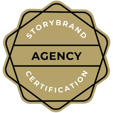Building Your StoryBrand: Brand Voice and Tone
by Kim Garmon Hummel, on Apr 28, 2021 12:00:00 AM
How your brand sounds is the difference between success and failure.
One way to ensure that your company is more than just a name or a logo is through storytelling. Sadly, businesses forget to consider the person that matters most in your brand—the customer.
If you fail to place your customer at the center for your brand story, you lose business.
One of the most important aspects of branding is voice and tone. How you position customers in your story, as well as how customers read your story, is vital in reaching intended business goals.
Your brand story elevates your company from just another organization to a brand that people will want to get behind and support. If you’re building a brand story, it means you already have a fully realized buyer persona. As you work through this blog, keep your buyer personas in mind. Imagine them in the room with you.
Consider your persona's pain points:
- What do your personas value?
- How do you communicate authority and empathy to your personas?
- Why is your business the right choice to solve your persona’s problem?
Your brand has the potential to transform your customers. A transformative journey from problem to solution generates intended business goals.
How To Build Your StoryBrand
Keep reading to learn the difference between tone, voice, and how to apply these rhetorical devices to your own brand story.
Building A Better StoryBrand: Voice
Your customers need to understand that your business is the right solution to their problems.
Remember—your brand voice is who the customers hear or think of when they engage with your brand.
Our brains can only handle so much input; your brand voice needs to be clear and direct. Messaging that doesn’t align with what your customers need results in dense, distracting noise. Building a brand voice that speaks to your customer’s pain points is an effective way to meet them along their journey.
To determine your brand’s voice, think about the words you want your audience to think of when they hear your company’s name or see your logo.
Write down all of the words you associate with your brand voice and circle the three most important.
Think about the experience you want customers to have in service and support and circle the three most important.
Some examples of brand voices include:
- MailChimp offers an incredibly insightful look into their brand voice. No matter what, their brand voice communicates that they understand their customer’s pain points.
- StoryBrand positions itself as a story-centric marketing guide that understands customers are the heart and soul of brand storytelling, not businesses.
- Sauce Agency shares a savvy, contemporary voice that positions Sauce as the growth guide and clients as the hero.
Understanding your brand’s voice at a higher level helps you and your team zoom in on what is vital to the voice of your brand’s story.
Building A Better StoryBrand: Tone
The tone is more than who your customers imagine speaking or writing; it’s the way of the writing itself. It’s how the logo feels.
Just as tone affects how we hear others, the tone of your brand impacts the very nature of how customers perceive your business.
Think about the way you want your brand to sound and look. Do you want to be friendly and joyful or analytical and urgent? Consider your competitors and what your buyer personas look for as you think about tone.
Write every word that pops into your mind and circle the three most important for your brand’s tone.
Some examples of a brand’s tone of voice include:
- Starbucks communicates to the rushed commuter their service is quick and effective at solving their need for caffeine. Their tone expresses a function and solution to a buyer persona’s problem
- Skittles strip away the phony marketing copy and cut through the noise with fun, bright language. Their team successfully captured what it feels like to eat Skittles through the effective application of tone in their brand voice.
- HubSpot’s tone shares a clear, considerate perspective on internal company behavior. They noticed customers actively ignoring or rejecting traditional marketing tactics. The answer? Software and service that focuses on customer positioning to generate meaningful leads and relationships.
What's the Difference Between Tone and Voice?
Your brand voice is static. Your brand’s tone of voice is dynamic.
Your brand’s voice, regardless of context, stays the same. But how you speak—your inflections, timbre, and physical process in which you say what you mean is tone. For your brand, tone of voice applies to the marketing copy, logo, colors, and distributed media.
Your tone of voice changes with your audience. I think back to childhood and how I’d actively shift my tone between parents, teachers, and friends.
Depending on the context, your tone changes to fit the situation. The same changes apply to your brand.
The context for tone in marketing is your buyer persona. You must apply and adapt your brand’s tone of voice to match what—and how—buyer personas want to hear. That’s how you cut through the noise and guide them to success.
How to Apply Voice and Tone to Your Brand's Story
Your brand must invite customers into your brand’s story. Your customers are the center of your story, and you are their guide (that's basic StoryBrand messaging). How can you apply voice and tone as a means to solve your customer’s problem? Empathy, authenticity, and authority.
People are motivated to solve internal problems. Don’t try to sell a product or service. Sell your business as the authoritative, informative guide to solve your customer’s internal problem.
You’ve probably heard this before: don’t sell the drill—sell the hole. Your business’ services do not motivate customers to act. The customer’s problem does. The solution to their problem? You and your services. If you demonstrate authority through an active voice, you reach your intended business goals.
Your brand’s story must explicitly communicate that it understands customer’s problems through a considerate, authentic tone. Expressing empathy for what customers are going through shares you care beyond a simple sale. Effective use of voice tone and brand story establishes an engaging relationship that generates business for years to come.
Sauce Agency: Your StoryBrand Agency
StoryBrand is a proven marketing framework that positions your customers as the hero of your brand. If your customers don’t understand that you understand their problems, they’ll find a business that does. At Sauce Agency, we’ll help you tell a Story That Sells, so you can identify your customer’s pain points and position your business as their guide to success. Schedule a call with a Growth Guide today.

.webp?width=12693&height=4513&name=Sauce%20Logo%20Dark%20Ht%20(1).webp)

.webp?width=180&height=64&name=Sauce%20Logo%20Dark%20Ht%20(1).webp)











